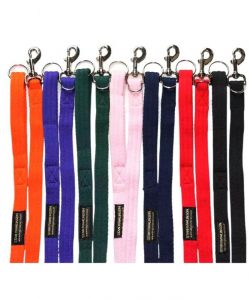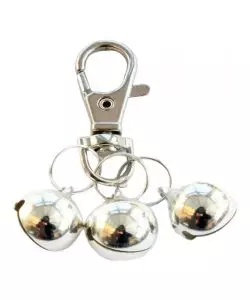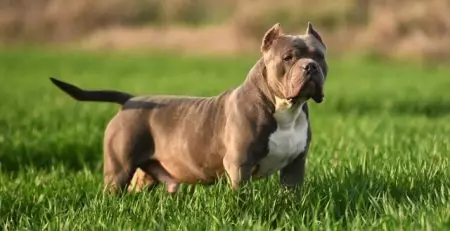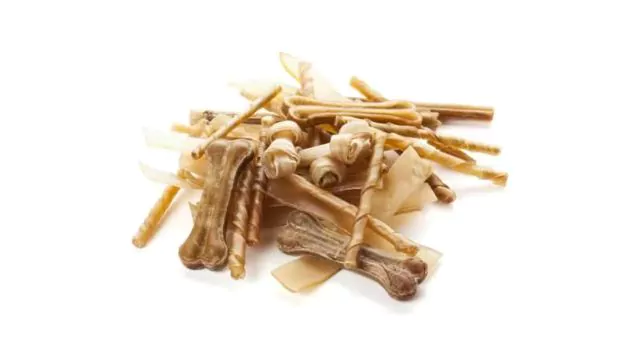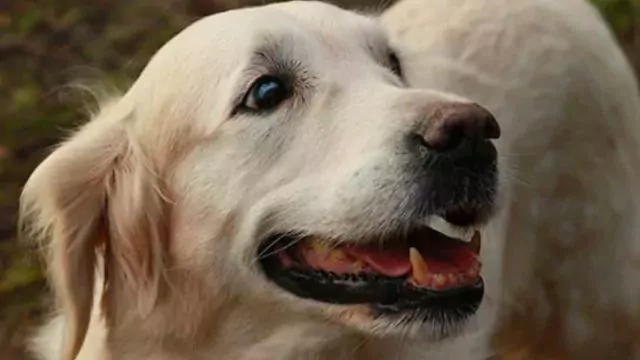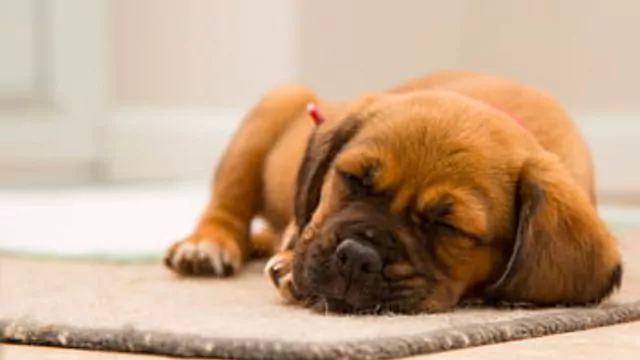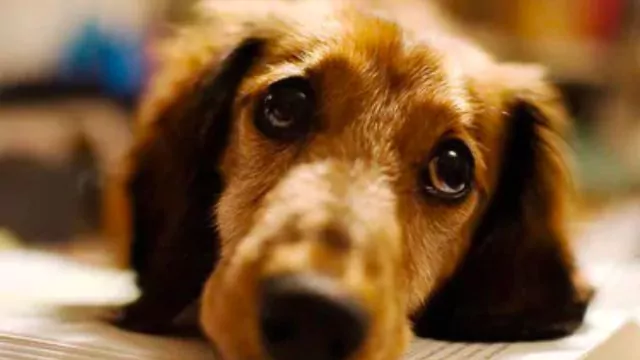Crate Training Puppies The Easy Way
Introducing a Crate to a Puppy
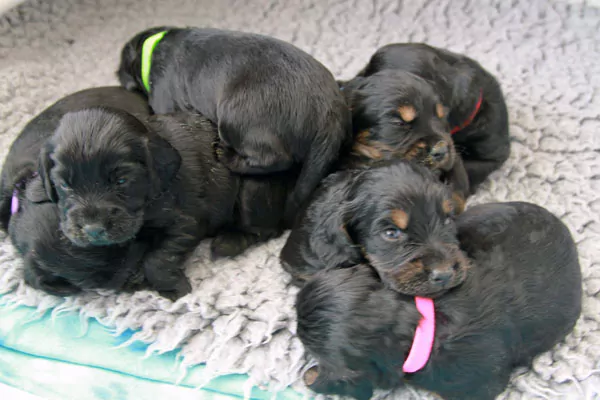
Think of how often dogs choose to sleep under the table, against a wall or behind the settee!.
Dogs in the wild seek out a safe haven where predators could not easily attack them.
These could be in a bole of a tree, a cave or any other shelter that would keep them safe and secure.
Although their resemblance to prison puts many people off in reality if they properly introduced it will be your dog’s safe haven for life.
Toilet Training: Crates are an extremely helpful aid for toilet training, and a haven when your dog is feeling stressed. Once your dog is happy in the crate, he can be left there to prevent soiling and chewing, when you are out for a short time.
Your pup can be restrained when the kids play noisy, energetic games, which are not improved by his joining in. He will have a secure familiar bed which can be taken in the car and on holiday or a secure place to stay when visiting relatives or friends.
It is even better if your breeder has introduced the puppies to a crate at a very early age. The puppies will feel comfortable and settled immediately. A dog which is thrust unprepared into a crate and left is going to associate the crate with an unpleasant experience, and be very unhappy about using them in the future.
A dog which is carefully introduced to a crate usually finds it a pleasant and secure place to be, so it is worth spending some time over the introduction process.
How to Crate Train Your Dog
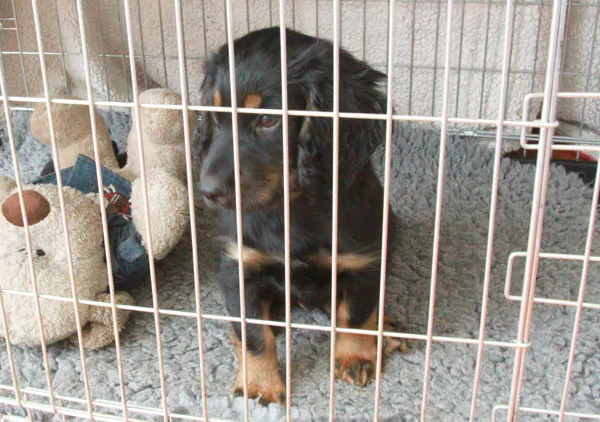
If he is a puppy, allow for growth. Cover the crate with a blanket or sheet so it is dark, den-like and cosy.
You can buy ready-made covers that fit snugly around the crate if the crate is quite big, section off part of it whilst the puppy is young with a separator a piece of plywood and some crates you can buy separators
This will prevent urinating or defecating in the corners. I sell the dividers with the crates if required.
Never put newspaper in the crate, this only stimulates the dog to toilet in there. Which defeats the object of using a crate for toilet training. Do not use puppy pads. They are impregnated with what I believe is horses urine, to stimulate the puppies to over-mark them. Therefore increasing the likelihood of them continuing to toilet indoors. To begin with, you will need to leave the crate set up all the time. Later you may prefer not to, and some crates like the ones I use are very easy to take up and down.
When left in the crate your dog should have toys and a natural long-lasting treat. I sell and import all natural (1) Air Dried Treats from Germany to keep him occupied when awake, soft bedding to sleep on, I prefer Vet Bed or the equivalent, and a drink of water. Get none spill bowls that can be used in the car and the house, then you don’t get spills or the puppy playing with the water.Initially feed the dog in the crate every day, with the door open. This is an easy way to get him to like it.
You should not be closing the door overnight until about 12 weeks of age, as the dog may become very distressed as it is unable to control bowel or bladder movements until the 12 week period. Therefore, a playpen with the crate inside it will allow the puppy to be safe and secure, and still be able to toilet overnight during this important period.
To keep the puppy safe whilst you are acclimatising it to the crate, purchase a playpen.you will never regret it. Especially when they really start teething at 17 weeks. I sell what I believe are the finest and safest crates on the market. Set the crate up in a quiet corner, and put the dog’s bed into it. At this stage, leave the door pinned open, so that the dog is never fastened in by mistake and therefore never gets overly stressed.
Soon the dog should happily use the crate voluntarily. When you reach this stage, (NOT BEFORE) wait until he goes in for a sleep, then close the door. Stay in the room, and let him out as he starts to wake up. When your dog is used to this routine, leave him for a minute after he wakes up, (with you still in the room). Gradually (over about a week) increase the time you can do this.
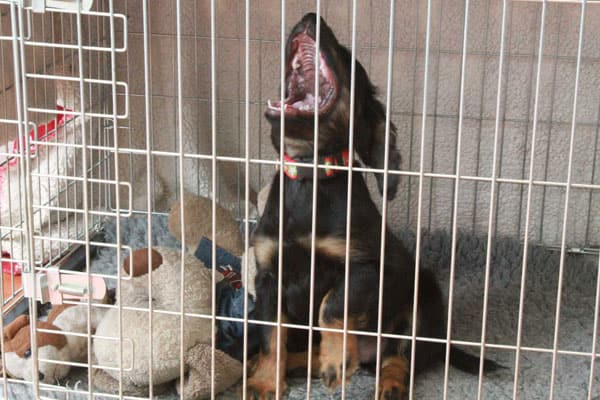
If your dog gets distressed, shorten the time on the next attempt, don’t make a big fuss, sympathy and lots of attention can make him think you’re praising him for being distressed.
He may play up for attention. Aim for the “nursing sister” approach, when she comes to give you a big injection. Be sympathetic but business like. See my article on (2).Separation Anxiety
When you can leave the dog with the door closed for a few minutes, leave the room for a short time but stay in the house.
Again, gradually increase the time you are out of sight until you can put the dog in his crate when you go out shopping.
Your dog should never be left in a crate for more than a couple of hours, except overnight. Please remember not to lock your puppy in overnight, until 12 weeks of age. I recommend using a playpen to allow the puppy room to move about and play. With the added safety of controlling him when he is teething and learning toilet training. He could be teething up to a year old.
This keeps your possessions safe and the pup away from harm such as electric cables or other dangerous objects. Then a (2) Playpen with the crate inside is a must. Other information can be found on my site at (3) Puppy Crying at Night, and (4) Toilet Training With A Crate
Stan Rawlinson 2012
Last updated June 2019
(1) All-Natural Air-Dried Dog Treats
(4) Toilet Training With A Crate
(5) Dog Crates





